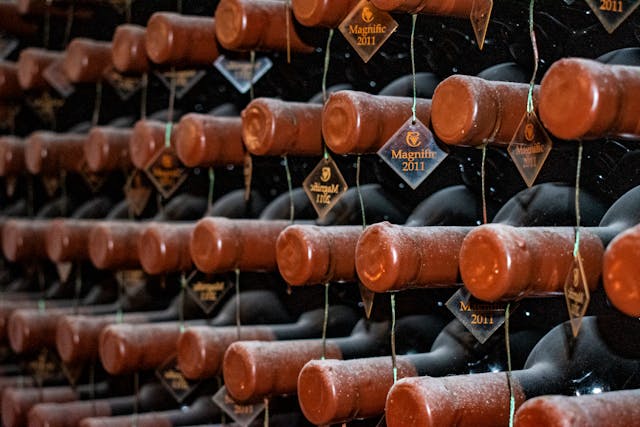
Why does wine improve as it ages? It doesn’t always, and some old bottles might not be that good. However, the wine that does improve has smoother tannins. It is probably accurate to say that the flavor of the wine changes with age, not necessarily that it gets better.
The oldest unopened bottle of wine in the world was bottled between AD 325 and 350, making it over 1,600 years old. It is a 1.5 liter amphora with handles that are shaped like dolphins. The bottle is sealed with wax and olive oil, which has kept the contents inside, but it probably doesn’t taste like wine anymore. It is doubtful that it has any alcohol left in it. It is called the Speyer Bottle because it was found in the tomb of a Roman nobleman who was buried in Speyer, Germany. Wine generally gets better with age, but there is a limit to that and it is very dependent on how the wine is stored. The Speyer bottle is probably drinkable, but it won’t taste very good.
Not all wines change with age and the majority of wines are made to be drunk very quickly. A lot of research time and money has been pumped into making wines that taste good without having to age. Because the world’s population is going up and because more people have money, more wine is sold per year than ever before and the majority is made just to be drunk. The market for wine goes up about $3 billion every year and it is a huge business. Even the wines that are meant to be drunk quickly are aged because the wines are stored in steel, oak, or ceramic vats, sometimes for a couple of years, before they are bottled. This can give wine its oaky flavor.
So, why do some wines get better after being left for a long time in the bottle? It all comes down to the tannins. Tannins are molecular compounds that many plants produce. They can be found in oak trees, and rhubarb. They are found in coffee and cacao. They are found in nuts, and they are found in grapes. Many of the foods that we love contain tannins, but what are they? Tannins are produced by plants as a natural pesticide. Tannins have a strong bitter taste, and most animals and insects don’t like the taste, which protects the plants. Unfortunately for the plants, if treated right, we love their taste. The tannins in wine come from the grape skins, the stalks, the seeds, and actually out of the oak barrels used to age the wine (which is why oak aged wines and whiskeys taste different). Tannins bind to proteins, especially the ones in your mouth and saliva when you drink wine, which leaves your mouth feeling dry and gives the bitter taste. The tannins in coffee (and the caffeine) can make your mouth dry as well.
The tannins in wine give the wine its texture and a lot of its flavor. It is these tannins that change as the wine ages and change the taste of the wine. Tannins are pretty small molecules, but, over time, they start to become less reactive and to join together. It takes a long time but the tannins become chains as they stick to each other and when enough tannins have stuck together they become too heavy to stay afloat in the wine and they sink to the bottom as sediment. As more tannins are pulled out of the wine, it becomes softer and has a more rounded, less bitter taste.
Oxygen also has an effect on the wine. Oxygen can oxidize the wine pretty quickly if it is left uncorked, but in the bottle, the cork makes a tight seal and only minute amounts of oxygen can get through. The bottles are also stored sideways so that the wine presses against the cork, making a better seal and stopping the cork from drying out. This stops a lot of oxygen getting in, but it is impossible to completely seal the bottle and the oxygen that comes through the cork gradually changes the color and the flavor of the wine. It makes a red wine into a browny color and it makes a white wine into a deep golden color. It also changes the flavor profile. However, too much oxygen can be a bad thing and wines meant from aging are kept out of the light, in humid conditions, at a controlled temperature of 5 to 18 degrees, and they are kept vibration free so the sediment can settle. Even though all of these things are known, it is still a gamble as to whether or not that 200-year-old bottle of red wine is going to be good or not. And that is what I learned today.
Photo by Ion Ceban @ionelceban from Pexels: https://www.pexels.com/photo/close-up-photo-of-brown-labeled-bottles-2580989/
Sources
https://coolersomm.com/blogs/wine-storage/how-does-oxygen-impact-wine
https://en.wikipedia.org/wiki/Tannin
https://daily.sevenfifty.com/the-science-of-tannins-in-wine
https://winehistorytours.com/the-oldest-wine-bottle
https://www.winespectator.com/articles/is-it-true-that-all-wine-improves-with-age
https://www.statista.com/outlook/cmo/alcoholic-drinks/wine/worldwide#revenue
https://home.binwise.com/blog/wine-better-age
